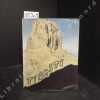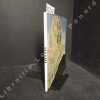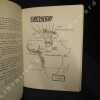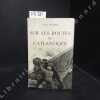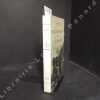-
Type
Book (1037)
Magazine (26)
Maps (3)
Photographs (2)
-
Latest
Last 24h (3)
Last 3 days (1)
Last month (8)
Last week (4)
-
Language
English (2)
French (1066)
-
Century
16th (1)
17th (1)
18th (24)
19th (135)
20th (210)
21st (64)
-
Countries
Belgium (127)
Canada (3)
Denmark (109)
France (749)
Switzerland (80)
-
Syndicate
ALAC (2)
ILAB (251)
NVVA (62)
SLACES (62)
SLAM (77)
Paris intime
in 12 demi cuir bleu à nerfs,titre,fers dorés,faux-titre, titre,332 pages,illustrations en noir dans le texte,Ernest Flammarion éditeur sans date,bon exemplaire
La belle histoire de LYAUTEY l’Africain
in 4 broché portrait de Lyautey, en couleurs,contrecollé sur le premier plat de la couverture,introduction d’André MAUROIS,1 feuillet,faux-titre,titre,XV,illustration photo. Sur papier couché.153 pages,2 feuillets de table des chapitre,table des illustrations.Editions Pau Duval sans date(1934)
Dictionnaire illustré des explorateurs et grands voyageurs français du XIXe siècle. II, Asie. [publ. par le] Ministère de l'éducation nationale et de la culture, Comité des travaux historiques et scientifiquesavec la collaboration de Gérard Siary
Paris, Édition du CTHS 1992 In-4 reliure éd. sous jaquette 31 cm sur 21. XXVI-452 pages, couverture illustrée. Jaquette en très bon état. Ouvrage illustré. Très bon état d’occasion.
Bibliographie, index. Très bon état d’occasion
"BROGLIE (DE BROGLIE), LOUIS DE . - DISCOVERY OF THE WAVE THEORY OF MATTER AND CREATION OF WAVE-MECHANICS
Reference : 49718
(1923)
Ondes et quanta. Note de M. Louis de Broglie, présentée par M. Jean Perrin. (Séance du 10 Septembre 1923). (+) Quanta de lumière, diffraction et interférences. Note de M. Louis de Broglie, transmise par M. Jean Perrin. (Séance du 24 Septembre 1923). (...
Paris, Gauthier-Villars et Cie, 1923. 4to. Bound in one contemp. full buckram. Spines gilt and with gilt lettering. In: ""Comptes Rendus Hebdomadaires des Séances de L'Academie des Sciences"", Tome 177. Bound with orig. printed front-wrapper to No. 1, half-title and title-page to vol. 177. 1513 pp. (Entire volume offered). De Broglie's papers: pp. 507-510, pp. 548-551 a. pp. 630-32. Clean and fine. A punched stamp on foot of title-page.
First edition of these papers which ESTABLISHED A NEW ERA IN PHYSICS by introducing the epochal new principle that particle-wave duality should apply not only to radiation but also to matter and thus CREATING QUANTUM MECHANICS. These 3 papers were extended to form his doctoral thesis of 1924 ""Recherches sur la Théorie des Quanta.""De Broglie relates ""After long reflection in solitude and meditation, I suddenly had the idea, during the year 1923, that the discovery made by Einstein in 1905 should be generalized by extending it to all material particles and notably to electrons"" (Preface to his PhD thesis 1924).""He made the leap in his September 10, 1923, paper: E=hv should hold not only for photons but also for electrons, to which he assigns a 'fictitious associated wave'. In his September 24 paper, he indicated the direction in which one 'should seek experimental confirmations of our ideas': a stream of electrons traversing an aperture whose dimensions are small compared with the wavelenght of the electron waves 'should show diffraction phenomena' .""(Pais ""Subtle is the Lord"", pp. 425-436).In the third paper (October 8) he discusses ""The interplay between the propagation of the particle and of the waves could be expressed in more formal terms as an identity between the fundamental variational principles of Pierre de Fermat (rays), and Pierre Louis Maupertuis (particles) as de Broglie discussed it further in his last communication . Therein he also considered some thermodynamic consequences of his generalized wave-particle duality. He showed in particular how one could, using Lord Rayleigh’s 1900 formula for the number of stationary modes for phase waves, obtain Planck’s division of the mechanical phase space into quantum cells.Louis de Broglie achieved a worldwide reputation for his discovery of the wave theory of matter, for which he received the Nobel Prize for physics in 1929. His work was extended into a full-fledged wave mechanics by Erwin Schrödinger and thus contributed to the creation of quantum mechanics. After an early attempt to propose a deterministic interpretation of his theory, de Broglie joined the Copenhagen school’s mainstream noncausal interpretation of the quantum theory.""(DSB).""This idea [i.e. de Broglie's that matter might behave as waves] was tested and confirmed by Davisson and Germer in 1927... Thus the duality of both light and matter had been established, and physicists had to come to terms with fundamental particles which defied simple theories and demanded two sets of 'complementary' descriptions, each applicable under certain circumstances, but incompatible with one another."" (Printing and the Mind of Man, 417).
"BROGLIE (DEBROGLIE), LOUIS de. - DISCOVERY OF THE WAVE THEORY OF MATTER AND CREATION OF WAVE-MECHANICS.
Reference : 46949
(1923)
Ondes et quanta. Note de M. Louis de Broglie, présentée par M. Jean Perrin. (Séance du 10 Septembre 1923). (+) Quanta de lumière, diffraction et interférences. Note de M. Louis de Broglie, transmise par M. Jean Perrin. (Séance du 24 Septembre 1923). (...
Paris, Gauthier-Villars et Cie, 1923. 4to. Bound in 2 contemp. full cloth. Spines gilt and with gilt lettering. In: ""Comptes Rendus Hebdomadaires des Séances de L'Academie des Sciences"", Tome 177. With htitle a. titlepage. 1513 pp. (Entire volume offered). De Broglie's papers: pp. 507-510, pp. 548-551 a. pp. 630-32. Clean and fine. A stamp to verso of titlepage.
First edition of these papers which ESTABLISHED A NEW ERA IN PHYSICS by introducing the epochal new principle that particle-wave duality should apply not only to radiation but also to matter and thus CREATING QUANTUM MECHANICS. These 3 papers were extended to form his doctoral thesis of 1924 ""Recherches sur la Théorie des Quanta.""De Broglie relates ""After long reflection in solitude and meditation, I suddenly had the idea, during the year 1923, that the discovery made by Einstein in 1905 should be generalized by extending it to all material particles and notably to electrons"" (Preface to his PhD thesis 1924).""He made the leap in his September 10, 1923, paper: E=hv should hold not only for photons but also for electrons, to which he assigns a 'fictitious associated wave'. In his September 24 paper, he indicated the direction in which one 'should seek experimental confirmations of our ideas': a stream of electrons traversing an aperture whose dimensions are small compared with the wavelenght of the electron waves 'should show diffraction phenomena' .""(Pais ""Subtle is the Lord"", pp. 425-436).In the third paper (October 8) he discusses ""The interplay between the propagation of the particle and of the waves could be expressed in more formal terms as an identity between the fundamental variational principles of Pierre de Fermat (rays), and Pierre Louis Maupertuis (particles) as de Broglie discussed it further in his last communication . Therein he also considered some thermodynamic consequences of his generalized wave-particle duality. He showed in particular how one could, using Lord Rayleigh’s 1900 formula for the number of stationary modes for phase waves, obtain Planck’s division of the mechanical phase space into quantum cells.Louis de Broglie achieved a worldwide reputation for his discovery of the wave theory of matter, for which he received the Nobel Prize for physics in 1929. His work was extended into a full-fledged wave mechanics by Erwin Schrödinger and thus contributed to the creation of quantum mechanics. After an early attempt to propose a deterministic interpretation of his theory, de Broglie joined the Copenhagen school’s mainstream noncausal interpretation of the quantum theory.""(DSB).""This idea [i.e. de Broglie's that matter might behave as waves] was tested and confirmed by Davisson and Germer in 1927... Thus the duality of both light and matter had been established, and physicists had to come to terms with fundamental particles which defied simple theories and demanded two sets of 'complementary' descriptions, each applicable under certain circumstances, but incompatible with one another."" (Printing and the Mind of Man, 417).
"BROGLIE, LOUIS de. - DISCOVERY OF THE WAVE THEORY OF MATTER AND CREATION OF WAVE-MECHANICS.
Reference : 46950
(1924)
A Tentative Theory of Light Quanta.
London, Taylor and Francis, 1924. Later full buckram, gilt lettering to spine. In: Philosophical Magazine conducted by Oliver Joseph Lodge etc."", Vol. 47. - Sixth Series. VIII,1168 pp. and 8 plates. (Entire volume offered). De Broglie's paper: pp. 446-458. Internally clean and fine.
First English version of the papers which ESTABLISHED A NEW ERA IN PHYSICS by introducing the epochal new principle that particle-wave duality should apply not only to radiation but also to matter and thus CREATING QUANTUM MECHANICS. The English paper is a translation of de Broglie's 3 ""Notes "" which he published in ""Comptes Rendus"" in September and October 1923 (Ondes et quanta. - Quanta de lumière, diffraction et interférences. - Les quanta, la théorie cinétique des gaz et le principe de Fermat). These 3 papers were extended to form his doctoral thesis of 1924 ""Recherches sur la Théorie des Quanta."" - This English edition (of the papers) was published before his thesis of 1924 as the paper is dated October 1, 1923, and published here in the Februar issue of Philosophical Magazine, months before the thesis.The English version contains furthermore an addition, a postscript, which contains a generalization of the theory which is consistent with the special theory of relativity, and NOT published in ""Comptes Rendues"" in 1923.With the three communications to the Academy of Sciences (the 3 Comptes Rendus papers) in the fall of 1923 de Broglie had presented the main ideas of his unified dynamics of light quanta and atoms. He was confident enough about his results that he submitted them also in English in the offered paper. At the end of the paper he summarized his results. De Broglie relates ""After long reflection in solitude and meditation, I suddenly had the idea, during the year 1923, that the discovery made by Einstein in 1905 should be generalized by extending it to all material particles and notably to electrons"" (Preface to his PhD thesis 1924).""He made the leap in his September 10, 1923, paper: E=hv should hold not only for photons but also for electrons, to which he assigns a 'fictitious associated wave'. In his September 24 paper, he indicated the direction in which one 'should seek experimental confirmations of our ideas': a stream of electrons traversing an aperture whose dimensions are small compared with the wavelenght of the electron waves 'should show diffraction phenomena' .""(Pais ""Subtle is the Lord"", pp. 425-436).In the third paper (October 8) he discusses ""The interplay between the propagation of the particle and of the waves could be expressed in more formal terms as an identity between the fundamental variational principles of Pierre de Fermat (rays), and Pierre Louis Maupertuis (particles) as de Broglie discussed it further in his last communication . Therein he also considered some thermodynamic consequences of his generalized wave-particle duality. He showed in particular how one could, using Lord Rayleigh’s 1900 formula for the number of stationary modes for phase waves, obtain Planck’s division of the mechanical phase space into quantum cells.Louis de Broglie achieved a worldwide reputation for his discovery of the wave theory of matter, for which he received the Nobel Prize for physics in 1929. His work was extended into a full-fledged wave mechanics by Erwin Schrödinger and thus contributed to the creation of quantum mechanics. After an early attempt to propose a deterministic interpretation of his theory, de Broglie joined the Copenhagen school’s mainstream noncausal interpretation of the quantum theory.""(DSB).""This idea [i.e. de Broglie's that matter might behave as waves] was tested and confirmed by Davisson and Germer in 1927... Thus the duality of both light and matter had been established, and physicists had to come to terms with fundamental particles which defied simple theories and demanded two sets of 'complementary' descriptions, each applicable under certain circumstances, but incompatible with one another."" (Printing and the Mind of Man, 417).This volume of Philosophical Magazine contains another importent paper in the history of Quantum Mechanics"": ""The Quantum Theory of Radiation"" by BOHR, KRAMERS AND SLATER, pp. 785-802. ""After Kramers had succeeded in extending the scope of the correspondence argument to the theory of optical dispersion ""thus rounding off a treatment of the interaction of atomic systems with radiation that accounted for all emission, absorption, and scattering processes"" Bohr ventured to propose a systematic formulation of the whole theory, in which what he called the virtual character of the classical model was emphasized. In this he was aided by Kramers and a young American visitor, J. C. Slater, and the new theory was published in 1924 under the authorship of all three. The most striking feature of this remarkable paper, ""The Quantum Theory of Radiation,"" was the renunciation of the classical form of causality in favor of a purely statistical description. Even the distribution of energy and momentum between the radiation field and the ""virtual oscillators"" constituting the atomic systems was assumed to be statistical, the conservation laws being fulfilled only on the average. This was going too far: the paper was hardly in print before A. H. Compton and A. W. Simon had established by direct experiment the strict conservation of energy and momentum in an individual process of interaction between atom and radiation. Nevertheless, this short-lived attempt exerted a profound influence on the course of events"" what remained after its failure was the conviction that the classical mode of description of the atomic processes had to be entirely relinquished."" (DSB).
Tibesti. Journal de route du voyage P. Brossette - G. Cavot dans le 83642, Mars-Avril 1953.
1954 Editions A.I.P.P.E. - 1954 - Edition sur Roto blanc des Papeteries Barjon et encarts sur Couché des Papeteries Navarre limitée à 500 exemplaires, n°381 - In-8, broché, couverture illustrée - 38 p. - Riche iconographie hors texte en N&B - Ouvrage non coupé (jamais lu)
Bon état - Légers plis et frottements sur la 1ère de couverture
Mikroskopische Beobachtungen über die im Pollen der Pflanzen enthaltenen Partikeln, und über das allgemeine Vorkommen activer Molecüle in organischen und unorganischen Körpern"" (Unterdem Titel: ""A brief Account of Microscopical Observations made in th...
Leipzig, Johann Ambrosius Barth, 1828. Without wrappers as issued in ""Annalen der Physik und Chemie. Hrsg.von Poggendorff"", Bd. 14, Zweites Stück. (=Jahrgang 1828, zehntes Stück). Pp. 191-306 a. 3 engraved plates. (the entire issue offered (Heft 2) together with the titlepage to 14. Band). Brown's paper: pp. 294-313. Clean and fine. Small stamp on verso of titlepage.
First appearance in German of this monumental paper in atomic theory and kinematics, as it was the first evidence for atomism that was an observation rather than a deduction from abstract principles.""In 1827 as he was viewing a suspension of pollen in Water under the microscope, he noted that the individual grains were moving about irregularly. This, he thought, was the result of the life hidden within the pollen grains. However, when he studied dye particles (indubitably nin-livin) suspended in water, he found the same erratic motion. This has been called ""Brownian motion"" ever since and Brown could merely report on the observation. He had no explanation for it. Nor had anyone else until the development of the kinetic theory of gases by men such as Maxwell a generation later. It seemed plain. after Maxwell and especially after the work of Einstein and Perrin a half century after Maxwell, that the Brownian Motion was actually a visible effect of the fact that water was composed of particles. It was the first evidence for atomism that was an observation rather than a deduction."" (Asimov).The issue contains other importent papers by C.. Naumann, G. Magnus, Th. Saussure ""Kohlensäuregas in der Atmosphäre"" andothers.PMM: 290 (the English paper from 1828) - Sparrow, Milestones of Science No 31. - Magie ""A Source Book in Physics p. 251-255. - Dibner, Heralds of Science No 156.
JAN ROMBOUTS. THE DISCOVERY OF AN EARLY SIXTEENTH-CENTURY MASTER IN LOUVAIN,
Turnhout, Brepols, 2011 Bound, black cloth, illustrated paper dustjacket, 210 x 305mm., 312 p., 237 b/w ill. 48 colour illustrations. . ISBN 9782503525693.
This monograph introduces the sixteenth-century Louvain artist Jan Rombouts (c. 1480 - 1535), whose oeuvre was previously assigned to Jan van Rillaer. Debates concerning Rombouts's identity are explored in detail by means of reinterpretation of published archival documents and the discovery of numerous new documents. The publication of the sources, most with full transcriptions, provides a sound basis for the author's arguments supporting the new identification.The remaining oeuvre of the artist, as it is known today, comprises engravings and paintings. This monograph argues for the expansion of Rombouts's oeuvre with some dozen stained-glass windows, roundels and a drawn design for a church window, while suggestions are put forth for other possible attributions. Attention is given to the historical context for Rombouts's activity as a glass painter, and the attributions of these works, none of which are monogrammed, are made by comparing their style with that of works securely attributed to the artist. This section is backed up by numerous illustrations of the windows, many of which are quite inaccessible. Finally, a discussion of archival sources concerning the Louvain confraternity of St Luke and commissions for works of art to local artists in the period covered by the book, form the rich historical background against which Jan Rombouts executed his oeuvre of engravings, paintings, roundels and stained-glass windows. The size, individuality, diversity and craftsmanship of this oeuvre enable us to finally identify and place him securely within the history of south Netherlandish art of his time. New book.
National Géographic - 100 ans d'aventures et de découvertes
PARIS, Nathan Image - 1988 - In-4 - Reliure toile éditeur sous jaquette illustrée en couleurs - Gardes illustrées - Très nombreuses illustrations NB et en couleurs, dans le texte et HT, certaines PP et double page - Bibliographie, index - 483 pages - Très bel exemplaire, comme neuf
- Livraison a domicile (La Poste) ou sur simple demande en Mondial Relay.- ATTENTION: Colis recommandé uniquement sur demande (parcel recommended on request). Si vous désirez un remboursement équivalent au montant de votre achat, en cas de perte détérioration ou spoliation, demandez-nous expressément un envoi en recommandé ( if you wish a repayment equivalent to the amount of your purchase, in case of loss - deterioration or despoliation, ask us expressly for a sending recommended)- Conditions de vente : Les frais de port sont affichés à titre Indicatifs (pour un livre) Nous pouvons être amené à vous contacter pour vous signaler le surcoût du au nopmbre de livres achetés ou du poids de ceux-ci. - Conditions of sale : The shipping costs are displayed as an indication (for one book) We may need to contact you to inform you of the cost of the additional shipping depending on the weight and the number of books- Possibilité d'envoi par Mondial-Relay - Réception en boutique sur rendez-vous. Librairie G. PORCHEROT - SP.Rance - 0681233148
La Découverte de Tahiti
France-Empire.1993.In-8,couv.souple illustrée en couleurs.383 p.Illustrations en noir.Etat neuf.
Guide d'Albanie.
"Tirana, Editions ""Albturist"", 1958." 13 x 19, 327 pp., quelques illustrations, broché, bon état (couverture légèrement défraîchie).
Traduction de Kolë Luka.
L'ours qui a vu l'homme: Rencontres avec la bête dans les récits d'exploration de la nuit des temps à nos jours
PAULSEN 2013 183 pages 12x2 2x17cm. 2013. Broché. 183 pages.
Très bon état
Sur les routes de l'Atlantique
1951 Editions Payot, Lausanne - 1951 - In-8, broché couverture illustrée à rabats - 262 pages - Avec une carte et trente-deux illustrations et reproductions photographiques en N&B hors texte
Bon état - Menus frottements sur la couverture
Bulletin de la Diana - publication trimestrielle - Régionalisme Loire - MontbrisonSommaire : A propos de la Charet de Forez N° 201 - Remise des insignes de chevalier des ARts et des Lettres à Noël Gandon - Découverte de monnaies des archevêques de Vienne à Pélussin - Un cas typique de l'avancée législative royale en Forez au XVIème siècle - Vivre à Sail-sous-Couzan à la veille de la Révolution de 1789 - Aimé Baune, un journaliste républicain devant la cour d'Assises de la Loire - A propos d'une intaille gallo-romaine découverte à Feurs - Pierre Kropotkine : éléments de bibliographie
2007 1 vol in-8 broché - 2 ème trimestre 2007 - Tome LXVI- N° 2 - 105 pages
Très bon état de conservation
Bulletin de la Diana - publication trimestrielle - Régionalisme Loire - MontbrisonSommaire : Les poésies de Christophe Boyer, curé de Saint-Bonnet-le-Château au XVIIème siècle - La commanderie de Saint-Jean-des-Prés à Montbrison - Les jardins de La Bastie au XVIIIème siècle - Découverte d'unecrédence dans l'églsie de Saint-Georges-en-Couzan
2001 1 vol in-8 broché -1er trimestre 2001 - Tome LX- N° 1 - 75 pages
Très bon état de conservation
Bulletin de la Diana - publication trimestrielle - Régionalisme Loire - MontbrisonSommaire : Notice nécrologique de Miss Sunderland - Rapport sur le musée de la Diana - Les vitraux de Notre-Dame de Laval - Le fer gaulois à Essalois, découverte de M. Boissier
1 vol in-8 broché - 1994 - Tome LIV- N° 4 - 65 pages
Très bon état de conservation
Bulletin de la Société Archéologique & Historique du LimousinDeux bagarres sanglantes à Saint-Yrieix au XVIIe siècle, par M. G. de Fromont de Bouaille - Le testament de Mgr de l'Isle du Gast, évêque de Limoges (1739), par M. Joseph Boulaud - Vieilles "hostelleries" dans l'histoire de Limoges, par M. Ernest Vincent - Léonard Gay de Vernon, maire-curé de Compreignac (période révolutionnaire), par M. le Dr L. Jouhaud - La fin de l'abbaye des Bénédictins, par M. Franck Delage Excursions urbaines d'archéologie en 1941 : Excursion du 18 mai : I. Itinéraire et commentaire, par M. Ernest Vincent - II. Vestiges archéologiques dans la cité de Limoges, par M. Albert de Laborderie / Excursion du 22 juin 1941, par M. Ernest VincentEglises de la Haute-Vienne (Sainte-Marie de Limoges, Aixe, Isle et Saint-Laurent-sur-Gorre), par M. Albert de Laborderie - Antiquités gallo-romaines à Roussac et à Balledent, par M. Franck Delage - Chrismatoires médiévaux de Limoges, par M. Chauncey-Ross - Les armoiries du Limousin, par MM. H. Hugon et F. Delage - Vase sigillé découvert à Limoges, par MM. F. Delage et G. Tyl - Inscription découverte à Limoges / Inscription retrouvée / Inscription du Buis, par M. F. Delage - A propos de deux pierres tombales de la cathédrale, par M. Septime Gorceix - Effet des guerres et du blocus, en 1794, dans le district de Limoges, par M. Ernest Vincent - La Place de l'Ancienne-Préfecture à Limoges, par M. Henri Hugon - Documents concernant l'ancien hôpital Saint-Martial de Limoges (F. Delage) - Vente par le directeur de la troupe des comédiens, d'accessoires de théâtre, à Louis Naurissart, directeur de la Monnaie (Joseph Boulaud)Procès-verbaux des séances : Année 1940 - 1941
Tome LXXIX - 1942 - Imprimerie R. Guillemot et L. de Lamothe. 18, rue Turgot, 18 - Revue illustrée - in-8 broché
assez bon état (couverture et dos légèrement abimés, petit manque sur la couv.)
Bulletin de la Société Départementale d'Archéologie et de Statistique de la Drôme
Reference : 36941
Bulletin de la Société Départementale d'Archéologie et de Statistique de la Drôme - Valence au secrétariat de la SociétéTable des matières : Notes pour l'histoire du Diocèse de Die par M. Brun-Durand - Annales de la ville de Romans pendnat les guerres de religion par le Dr Ulysse Chevalier - Etude historique sur l'ancienne organisation judiciaire de la ville de Valence par M. E. Fayard - Petite anthologie des poètes de la Drôme par Mr Jules Saint-Rémy - Découverte à Vienne d'une statue enbronze et de deux inscriptions sur plaques de bronze par M. A. Allmer - Les sources de l'histoire par M. Zénon Fière
1 vol in-8 broché - 119 pages - années 1875 - Tome IX - 33 ème livraison
assez bon état - Couverture et dos légèrement fragiles - intérieur propre
Bulletin de la Société Départementale d'Archéologie et de Statistique de la Drôme
Reference : 37235
Bulletin de la Société Départementale d'Archéologie et de Statistique de la Drôme - Valence au secrétariat de la Société Notice historique sur Saint-Paul-Les-Romans ( 4ème article ) par M. A. Lacroix - Le Dauphiné en 1698 ( 4 ème article ) par M. Brun-Durand - La linguistique au service de l'histoire ( 3ème article ) par M. J. A. Bello - Notice historique sur le couvent des Cordeliers de Romans ( 1er article ) par l'abbé Chevalier - Statistique écclésiastique : Pouillé du diocèse de Vienne ( 3ème article ) par l'abbé Chevalier ) - Bibliographie : Essai historique sur l'abbaye de Saint-Barnard et sur la ville de Romans par M. Giraud ( 2ème partie par M... - Statistique : le prix du pain par M. A. Lacroix - Une ville inconnue découverte sur le territoire de Saint-Maurice par M. A. Boisson - LA température à Valence en 1866 par Gédéon Bresson - Ventia par M. Courbassier - Une machine à battre au XVIIème siècle - Tauroble de Tain
1 vol in-8 broché - 115 pages - années 1867 - Tome II - 5 ème livraison
assez bon état - Petite déchirure au milieu du dos - intérieur propre
Bulletin de la Société Départementale d'Archéologie et de Statistique de la Drôme
Reference : 42230
Bulletin de la Société Départementale d'Archéologie et de Statistique de la Drôme - 24ème année - 1890 - Valence au secrétariat de la Société Météorologie régionale par Marius Villard - Dictionnaire des devises héraldiques, numismatiques, historiques et fantaisistes du Dauphiné par M. G. Vallier - Les amis de Jean Dragon, professeur à l'Académie protestante de Die par M. J. Brun-Durand - Petit glossaire patois des végétaux du Dauphiné par l'Abbé Moutier - Colonne militaire découverte à Saint-Didier-de-Charpey par Jules Chevalier - Les monnaies frappées à Montélimar pendant le règne de Louis XII par Roger Vallentin -
Tome XXIV - janvier 1890 - 92e livraison - 1 vol in-8 broché - 116 pages
Dos fendu - petite déchirure sur le premier plat - intérieur propre
Bulletin de la Société Départementale d'Archéologie et de Statistique de la Drôme
Reference : 42239
Bulletin de la Société Départementale d'Archéologie et de Statistique de la Drôme - 1887 - Valence au secrétariat de la Société Essai historique sur le Vercors par l'Abbé Fillet - Correspondance d'Achard de Germane avec M. de la Coste par l'Abbé Cyprien Perrossier - Recherches sur les évêques originaires du diocèse de Valence par l'abbbé Cyprien Perrossier - Découverte d'un trésor du XVIème siècle à Montélimar par Roger Vallentin - Mémoires d'Achille Gamon par M. Brun-Durand - Météorologie régionale par Marius Villard - Terriers rédigés en 1401 et 1500 en faveur d'une branche de la famille de Puy-Montbrun par M. Le Baron de Coston -
Tome XXI - 21ème année - Octobre 1887 - 83e livraison - 1 vol in-8 broché - 111 pages
Bel état de conservation - Dos fragile
Bulletin de la Société Départementale d'Archéologie et de Statistique de la Drôme
Reference : 42340
Bulletin de la Société Départementale d'Archéologie et de Statistique de la Drôme - 1907 - Valence au secrétariat de la Société Chronique par M. Lacroix - Bibliographie par M. A Lacroix et M. Brun-Durand - Découverte d'une porte de la Maison des Têtes et les monuments de la Renaissance à Valence par Marius Villard - Châteauneuf-de-Mazenc par M. H de Terrebasse - L'invasion de 1814 à Tain, chute de l'Empire, rétablissement de la royauté ( 28 mars-13 avril ) par M. Charles Bellet - Notice sur Pierre de Chalus, abbé de Cluny ( 1320-1342 ) et évêque de Valence ( 1342-1352 ) par M. Charles Bellet - les origines de Saint-Antoine ( isère ) par Dom Germain Maillet Guy - Le tramway de Valence à Crest par M. A. Lacroix - La population des TAillabilités du Dauphiné en 1698 par R. V. C
Tome XLI - 41ème année - avril 1907 - 161e livraison - 1 vol in-8 broché - 127 pages
Assez bon état - Petite déchirure au bas du dos
 Write to the booksellers
Write to the booksellers![Dictionnaire illustré des explorateurs et grands voyageurs français du XIXe siècle. II, Asie. [publ. par le] Ministère de l'éducation nationale et de ...](https://static.livre-rare-book.com/pictures/AVE/141868_1_thumb.jpg)
![Dictionnaire illustré des explorateurs et grands voyageurs français du XIXe siècle. II, Asie. [publ. par le] Ministère de l'éducation nationale et de ...](https://static.livre-rare-book.com/pictures/AVE/141868_2_thumb.jpg)
![Dictionnaire illustré des explorateurs et grands voyageurs français du XIXe siècle. II, Asie. [publ. par le] Ministère de l'éducation nationale et de ...](https://static.livre-rare-book.com/pictures/AVE/141868_3_thumb.jpg)







